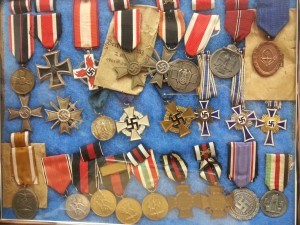
Welcome to WW2Buyer.com
David Mattey of WW2Buyer.com
is a conscientious dealer with over 40 years experience in the purchase and sale of Medals ,Decorations , Arms and Militaria.

David who has worked from his high street premises for the last twenty years acts as buyer to city investment groups ,Advanced collectors and the premier specialist websites.

David believes that investors are happy to pay a premium for expertise, research and unconditionally guaranteed exhibits.

WW2Buyer.com are engaged in the purchase of Allied And Axis Uniforms ,Daggers,Medals, Awards, Orders, Decorations and associated “Militaria.

If you believe you have already obtained a fair offer David welcomes the opportunity of offering a confidential second opinion.

Call or e-mail davidmatteybuyer@gmail.com today for free advice and valuations. please feel free to use the contact form provided.

Our offers and valuations both free of charge and confidential.

If you have by your own research, established an asking price or obtained bids from other parties.

Please include offers in your communications.
WW2Buyer.com are not in the business of haggling if we can see modest margin we will advance payment today.

Before consigning militaria for sale by auction please be aware that 35%-44% of the total paid by the buyer will be lost to the auctioneer. If you have obtained suggested reserve figures from auctioneers
WW2Buyer.comwill pay 100% of these immediately.

Contact: David Mattey
Tel: 01903-884602 Mobile 07860747027
or e-mail:davidmatteybuyer @gmail.com

Immediately after the Second World War, the victorious Allies carried out the largest forced population transfer—and perhaps the greatest single movement of peoples—in human history. With the assistance of the British, Soviet, and U.S. governments, millions of German- speaking civilians living in Czechoslovakia, Hungary, and the parts of eastern Germany assigned to Poland were driven out of their homes and deposited amid the ruins of the Reich, to fend for themselves as best they could.

Millions more, who had fled the advancing Red Army in the final months of the war, were prevented from returning to their places of origin, and became lifelong exiles. Others again were forcibly removed from Yugoslavia and Romania, although the Allies had never sanctioned deportations from those countries.
Altogether, the expulsion operation permanently displaced at least 12 million people, and perhaps as many as 14 million. Most of these were women and children under the age of sixteen; the smallest cohort of those affected were adult males. These expulsions were accomplished with and accompanied by great violence. Tens and possibly hundreds of thousands lost their lives through ill- treatment, starvation, and disease while detained in camps before their departure—often, like Auschwitz I, the same concentration camps used by the Germans during the Second World War. Many more perished on expulsion trains, locked in freight wagons without food, water, or heating during journeys to Germany that sometimes took weeks; or died by the roadside while being driven on foot to the borders. The death rate continued to mount in Germany itself, as homeless expellees succumbed to hypothermia, malnutrition, and other effects of their ordeal. Calculating the scale of the mortality remains a source of great controversy today, but estimates of 500,000 deaths at the lower end of the spectrum, and as many as 1.5 million at the higher, are consistent with the evidence as it exists at present. Much more research will have to be carried out before this range can be narrowed to a figure that can be cited with reasonable confidence.

On the most optimistic interpretation, nonetheless, the expulsions were an immense manmade catastrophe, on a scale to put the suffering that occurred as a result of the “ethnic cleansings” in the former Yugoslavia in the 1990s in the shade.

They took place without any attempt at concealment, under the eyes of tens of thousands of journalists, diplomats, relief workers, and other observers with access to modern communications, in the middle of the world’s most crowded continent. Yet they aroused little attention at the time.

Today, outside Germany, they are almost completely unknown. In most English- language histories of the period they are at best a footnote, and usually not even that. The most recent (2009) edition of Mary Fulbrook’s excellent History of Germany 1918–2008 disposes of the episode in a single uninformative paragraph; the antics of the tiny ultraleftist Red Army Faction in the 1970s and 1980s, in comparison, rate four.

The Cambridge Illustrated History of Germany is typical in not according the expulsions even a single mention. What is true of German history textbooks is also the case with those dealing with the history of Europe as a whole, and even of the central European states most directly concerned. Joseph Rothschild and Nancy Wingfield’s fine survey of the region in the postwar era, Return to Diversity —by far the most accessible and reliable one-volume treatment of the subject—takes a cumulative total of less than a page to explain the means by which Poland and Czechoslovakia, until 1939 among the most heterogeneous and multicultural countries in Europe, had just ten years later become ethnic monoliths. It is, then, entirely understandable why so many of my splendid and learned colleagues on the Colgate faculty should have expressed their confusion to me after reading in the newspapers in October 2009 that the president of the Czech Republic, Vaclav Klaus, had demanded that the other members of the European Union legally indemnify his country against compensation claims by ethnic German expellees, as the price of his country’s ratification of the Lisbon Treaty. None had been aware that anything had occurred after the war in respect of which the Czech Republic might require to be indemnified.
It would be incorrect, however, to attribute this pervasive ignorance of the expulsions, their context, and their consequences to any conspiracy of silence. What has occurred in the postwar era is something less calculated in nature, but more insidious in effect:

the phenomenon of a historical episode of great significance that is hidden in plain sight.

Certainly information, albeit of highly variable quality, on the expulsions is available—for those who possess the requisite language competence and are prepared to go looking for it. A 1989 bibliography lists almost five thousand works dealing with them to some degree in the German language alone. Even today, some sixty- five years later, living expellees are not hard to find; it has been calculated that a quarter of the current German population are expellees or their immediate descendants. What is denied, then, is not the fact of the expulsions but their significance. Relegated in textbooks to a single passing mention in a vaguely phrased sentence referring to the “chaos” existing in Germany in the immediate postwar era, or simply passed over in silence, the impression is effectively conveyed that they occupy a less important place in modern European history than the cultural meanings of football hooliganism or the relevance of the Trabant automobile as a metaphor for East German society.
Why this should be so is not difficult to understand, because any discussion of the expulsions immediately brings to the fore a host of deeply uncomfortable and—still—highly contentious and divisive questions. For Germans themselves it invites debate over the dubious wartime record of the ethnic German minorities living outside the Reich—the so- called Volksdeutsche —and the degree to which they can be considered to have drawn their eventual fate upon themselves. For Poles, Czechs, Slovaks, and citizens of other expelling countries, it complicates and undermines a series of national narratives, supported by overwhelming consensus, of Germans exclusively as perpetrators and their own peoples exclusively as victims, as well as raising concerns about the durability of the legal arrangements through which ex- German properties came into the possession of their current owners. For citizens of the Allied countries, and especially those of the United States and Britain, it invites scrutiny of the complicity of their leaders and peoples in one of the largest episodes of mass human rights abuse in modern history, which bore a disturbing resemblance in some respects at least to Nazi Germany’s wartime effort to reconfigure the demographic contours of the continent by similar means.
The history of the expulsions is one from which few if any of those directly involved emerge in a creditable light. It is not surprising, then, that there should be a great deal of reluctance to try to integrate a messy, complex, morally compromised, and socially disruptive episode that remains to this day a political hot potato into the history of what most people still rightly consider a justified crusade—or, as Americans put it, a “Good War”—against one of the most monstrous regimes of modern times.
In the long run, however, this refusal to engage with the expulsions and their meaning not just for European history but for our contemporary world is unwise as well as unsustainable. For one thing, to do so is in effect to concede the field to individuals like Holocaust “revisionists” who, seeking to equate the expulsions with the extermination of the European Jews as “war crimes” that counterbalance each other, do not scruple to pervert the historical record for their own ends. For another, from a scholarly perspective it ignores the revolution in central European historiography that has been under way since the collapse of the Communist empire in 1989. With the opening of official archives in Poland, the Czech Republic, Slovakia, Hungary, and some at least of the Yugoslav successor states, polemical and ahistorical treatments of the subject have begun to be supplanted by well- researched empirical studies of the policies and processes of expulsion. Although an immense amount of investigation remains to be done in this field, the pioneering studies of scholars like Tomaš Staněk for the Czech lands, Bernadetta Nitschke and Bernard Linek for Poland, Soňa Gabzdilov and Milan Olejnak for Slovakia, Vladimir Geiger and Zoran Janjetović for the former Yugoslavia, as well as many others, are accomplishing a transformation in our understanding of the immediate postwar history of central and southeastern Europe. Their work has been broadened and supplemented by an unusually talented cohort of younger Western scholars of the region, among whom the names of Chad Bryant, David Curp, Benjamin Frommer, David Gerlach, Eagle Glassheim, Padraic Kenney, Jeremy King, Andrea Orzoff, and Tara Zahra figure prominently.
For all of them, the expulsions and their effects are pivotal factors in explaining what these countries became after the Second World War, and what, despite the fall of Communism, in many respects they remain today. German historians too, working alongside and in cooperation with their counterparts in the countries that were the scene of the expulsions, have made contributions of great importance in this area during the past fifteen years, although paradoxically the justifiable concern of many of them to ensure that discussion of the expulsions does not become the basis for a self- pitying “victim” mentality, in which questions of culpability for Nazi crimes are pushed to the background, has given the debate in that country a sharper tone than elsewhere.
What is lacking at present, however, is a study of the expulsions that examines the episode in the round—from the time of its earliest origins and in all of the countries affected—and that carries the story forward to the present day where it continues to cast a long shadow across European and world events. That is what Orderly and Humane attempts to do. It is appropriate at the outset to state explicitly that no legitimate comparison can be drawn between the postwar expulsions and the appalling record of German offenses against Jews and other innocent victims between 1939 and 1945. The extent of Nazi criminality and barbarity in central and eastern Europe is on a scale and of a degree that is almost impossible to overstate. In the entire span of human history, nothing can be found to surpass it, nor, with the possible exception of recent revelations about Mao’s China, to equal it. Germany’s neighbors suffered most grievously and unjustifiably at her hands, and were profoundly traumatized as a result. Whatever occurred after the war cannot possibly be equated to the atrocities perpetrated by Germans during it, and suggestions to the contrary—including those made by expellees themselves—are both deeply offensive and historically illiterate. Nothing I have written in the book should be taken to suggest otherwise.
But it is a long way from there to conclude that the expulsion of the Germans was inevitable, necessary, or justified. The expelling countries, needless to say, maintained that it was all of those things. Both at the time and to the present day, commentators from outside the region, for wholly understandable reasons, have been reluctant to challenge the judgment of peoples who suffered so greatly under German occupation. When we examine closely the record of the largest forcible population transfer in human history, however, we find that the result is a tragic and largely destructive episode that never fulfilled its professed aspirations— even in the extreme circumstances of postwar Europe when, if anything could ever have justified the use of such an expedient, this situation would.




















